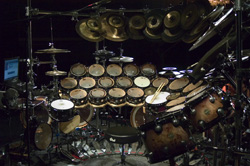
Sub Kick
This particular miking trick is one that can be used to bring great low-end presence to the kick drum.
By way of explanation, a short stand holding essentially the woofer of a speaker is placed in front of the kick drum and picks up predominantly the low frequencies.
When blended with the kick drum mic, the sub-kick generates great power in the lowest part of the frequency.
In order to accentuate the most important elements of the sub kick’s sound, I tend to use a low pass filter approach to my EQ that removes all frequencies above 500hz and drops off even more dramatically below 100hz.
This is to make sure that only the essential parts of the sub kick’s sound come through.
The sub kick should be felt more than it is heard. In terms of compression, a ratio of approximately 5:1, a relatively slow attack (120ms) and medium fast release (57ms) allow the sub kick’s tone to stay present and full underneath the sound of the kick drum’s regular miked sound.
Then, I’ll use a noise gate with a fast attack (20ms) and slower release (200ms) to keep out any other kit sounds that might otherwise bleed into the sub kick sound.
Snare
Along with the kick drum, the snare drum is essential for driving a rhythm track. Poor EQ and compression techniques can leave it sounding thin, dull and generally uninspired.
In order to accentuate the best parts of the snare sound with EQ, I’ll boost the low end of the snare by 2-3dB at around 80hz, cut 2-3dB between 350-450hz and then boost again, if necessary, for more high-end brightness, by 1-2dB at 5k. These three EQ points are a great place to start to sculpt an interesting snare sound.
Compression on a snare is a real balancing act where too much will take away the energy of the performance and too little will make it practically impossible to find an appropriate level for the snare in the mix.
I use a ratio of 2.5:1 with a very quick attack (2ms) and release (11ms). If you’re finding that you’re losing the snap of the snare, slow your compressor’s attack a little but remember that slowing the attack too much will take the compressor too long to grab onto the sound and will leave the snare much less manageable in the mix.
Adjust the threshold settings until things sound right to your ear. This basically allows you to decide how much overall compression you’ll be applying. Don’t overdo it or the drum will lose its energy but don’t go too lightly or the snare won’t stand up in the mix. Gating the snare is a trial and error process as well.
Depending on whether the snare approach in the song is aggressive or soft will have a lot to do with your threshold settings. Like on the kick drum, I use the very fast “auto” attack and a slower release on the gate in an attempt to keep out the ambient sounds of the cymbals, toms and kick.


